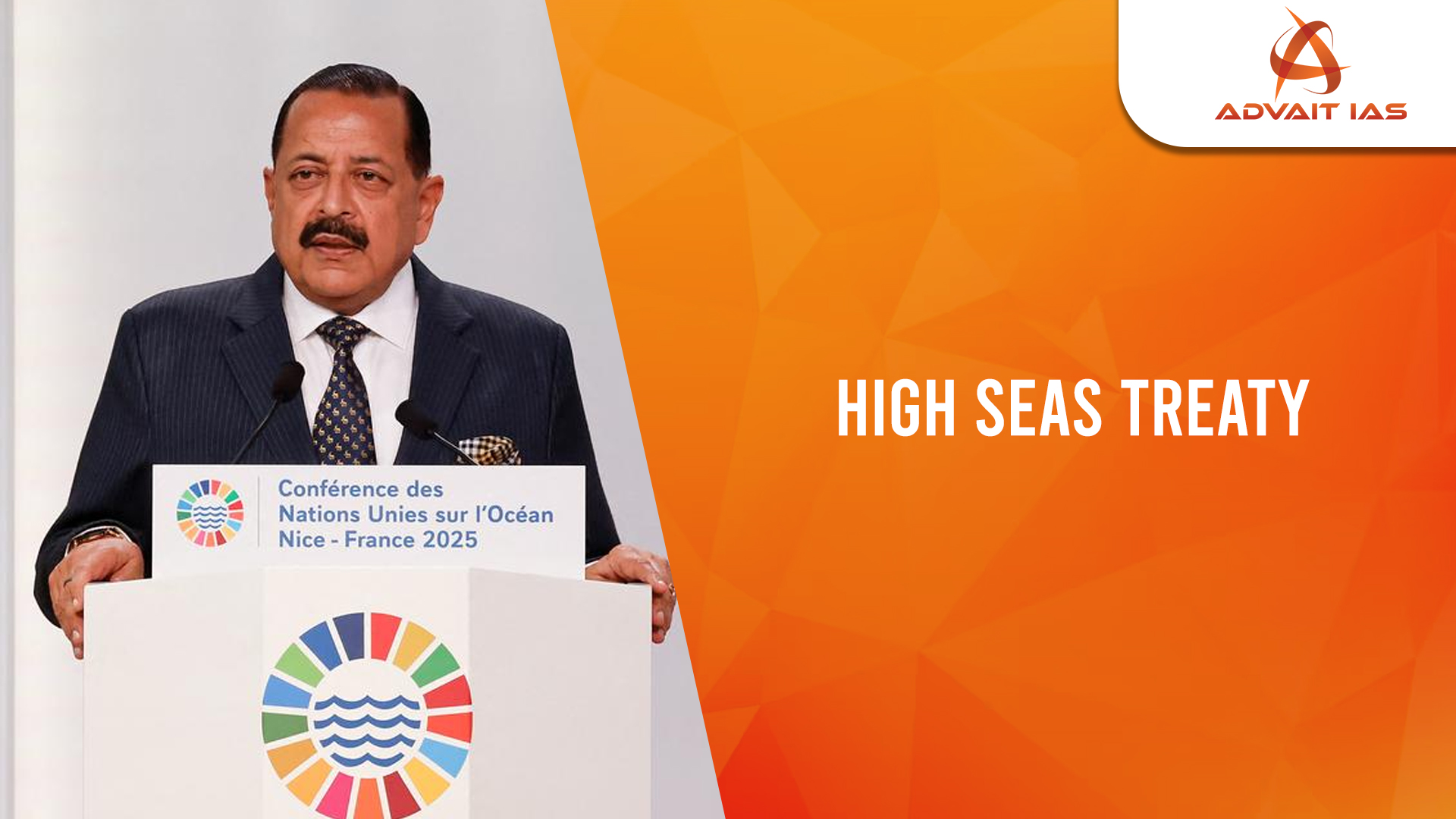The High Seas Treaty, also called the Biodiversity Beyond National Jurisdiction (BBNJ) Treaty, was adopted by UN member states in June 2023.
- Eighteen additional countries ratified the High Seas Treaty bringing the total to 49 countries; the treaty comes into force after 60 ratifications (120 days post the 60th ratification).
- The treaty aims to protect marine biodiversity in international waters, which constitute over 60% of global oceans.
The treaty is crucial to meet a globally agreed biodiversity target of protecting 30 per cent of the oceans and lands by 2030, known as “30×30”.
Key Provisions of the Treaty
1. Jurisdiction: International Waters
- Applies to oceans beyond national exclusive economic zones (EEZs) (beyond 200 nautical miles).
- Covers “The Area” – seabed and subsoil beyond national jurisdiction, which is over half of Earth’s seabed.
2. Conference of the Parties (COP)
- A decision-making body to be established once the treaty is enacted.
- Will coordinate with existing institutions like:
- Regional fisheries management organizations,
- International Seabed Authority (ISA).
- Will oversee enforcement, data sharing, and marine conservation efforts.
3. Marine Protected Areas (MPAs)
- Enables creation of MPAs in open oceans, not just national waters.
- MPA designation can be done via:
- Consensus, or
- Three-fourths majority voting, to avoid deadlocks.
- Monitoring challenges: Enforcement mechanisms are undefined.
- Experts propose using satellite surveillance.
- Enforcement will largely depend on COP mechanisms and national jurisdiction over flag-bearing ships.
4. Marine Genetic Resources (MGRs) and Benefit Sharing
- Countries may collect genetic material from marine organisms for scientific or commercial use (e.g., pharmaceuticals).
- Issues:
- Rich vs poor country conflict over fair sharing of profits.
- Treaty provides:
- Technology transfer and capacity building for developing nations.
- Open access to research data.
- But monetary benefit sharing mechanisms are left to be determined by COP, with proposals including:
- Product-based royalties,
- Global access fee systems.
5. Environmental Impact Assessments (EIAs)
- Requires countries to assess the environmental impact of activities in high seas before authorization.
- Applies to:
- Activities with more than minor or transitory effects,
- National activities with transboundary impacts on international waters.
- NGOs sought to give COP the final approval power, but states retain decision-making power.
- States must:
- Publish updates on environmental impact,
- Reassess if new, unexpected impacts emerge.
6. Regulated Activities (Examples)
- The treaty could potentially apply to:
- Fishing and marine transport,
- Deep-sea mining,
- Geoengineering projects for climate mitigation,
- Other industrial activities with ecological impact.
Significance of the Treaty
- First international legal framework for protecting biodiversity in the high seas.
- Supports Sustainable Development Goal 14 (Life Below Water).
- Promotes equity, conservation, and science-based marine governance.
- Seen as critical for addressing climate change, biodiversity loss, and unsustainable exploitation of marine resources.
Achievement of ‘30×30’ Initiative:
- Objective: To protect 30% of the Earth’s land and ocean by 2030 to halt biodiversity loss and safeguard ecosystems.
- Launched by: High Ambition Coalition for Nature and People in 2020.
- Support: Over 100 countries, including India, USA, UK, and EU.
- Legal Backing: Incorporated as a target in the Kunming-Montreal Global Biodiversity Framework at COP15 of the Convention on Biological Diversity (CBD).
- Significance:
- Addresses climate resilience and biodiversity conservation.
- Promotes equity through involvement of indigenous communities and developing nations.
- Encourages creation of Marine Protected Areas (MPAs) in high seas and terrestrial conservation zones.
United Nations Convention on the Law of the Sea (UNCLOS):
- Established: Came into force in 1994; also known as the Law of the Sea Treaty.
- Purpose: Provides a comprehensive legal framework for maritime governance and resource use.
- Key Provisions:
- Defines Internal Waters, Territorial Waters (12 nm), Contiguous Zone (24 nm), EEZ (200 nm), and Continental Shelf.
- Grants landlocked countries rights of sea access without unjust taxation.
- Obliges states to protect the marine environment and permits scientific research on the high seas.
- Institutional Mechanisms:
- International Tribunal for the Law of the Sea
- International Seabed Authority (ISA)
- Commission on the Limits of the Continental Shelf
- Liability: States can be held liable for marine environmental damage due to treaty violations.
- Membership: 167 countries and the European Union are parties; India is a member.
- Exclusion: USA has signed but not ratified the treaty.






